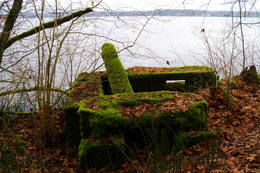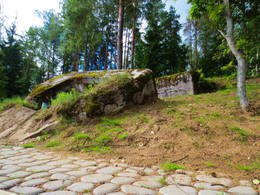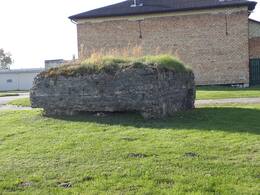Pastangos užkirsti kelią Kegumo HE sprogimui
Antrojo pasaulinio karo metu, armijoms traukiantis, Latvijoje buvo susprogdinta daug kariniu ir logistiniu požiūriu svarbių objektų, kad šie ištekliai neliktų priešui. Tokie objektai buvo ir Kegumo apylinkėse, kur vienas svarbiausių objektų yra Kegumo HE, kuri, jos darbuotojų pastangų ir pastangų dėka, nebuvo visiškai sunaikinta.
Papasakosiu apie tą dieną taip, kaip girdėjau ir kaip sužinojau rinkdamas dokumentus Kegumo istorijos muziejui. Yra keletas žinomų faktų, bet yra ir daug nežinomų faktų, kurie vargu ar bus iki galo išaiškinti.
Žinant, kaip vokiečiai viską susprogdina, ši perspektyva buvo aiški ir Kegumo gyventojams. Dar aiškiau, kai Kegume dislokuotas sargybos dalinys „Sonderkommando“ pradėjo minuoti tiltą, Kegumo HE direktorius Pāvelas Krasovskis ir tikriausiai jo bendražygiai bei bendražygiai, kurių vardų nežinome, galvojo ir aktyviai dirbo, kad kuo labiau išgelbėtų elektrinę. Krasovskis liepė užmūryti įėjimo galerijas po užtvanka, kad ten nebūtų galima padėti bombų. Būdamas medžiotojas, jis buvo išvykęs į Sunākstus medžioti, nors jau 1942 m. Vokietijos vietos valdžia atsisakė pratęsti jo leidimą laikyti medžioklės ginklus (faktas). Tačiau iš tikrųjų jis ten esą susitiko su Oškalnso vadovaujamo partizanų būrio vyrais su Samsonu. Jie esą susitarė, kad rugsėjį Samsonas ir jo vyrai užims Kegumą, užkirs kelią bombardavimui ir laikys jį, kol atvyks rusai. Šis planas buvo žinomas ir Rusijos armijos vadovybei. Tai liudija faktas, kad Rusijos aviacijai bombarduojant visus strategiškai svarbius mazgus, Kegumas niekada nebuvo užpultas. Taip pat ir tai, kad liepos 28 d. Tomo pusėje buvo numestas desantas su kodiniu pavadinimu „Raudonoji strėlė“, kuris tikriausiai turėjo bendradarbiauti su Samsonu šioje operacijoje. Tačiau veikė ir vokiečių šnipų mašina, ir rugsėjo viduryje desantas per kelias dienas buvo visiškai sunaikintas. Krasovskis žmonai pasakė, kad Samsonas neatvyko nustatytu laiku. Samsonas sako, kad dėl išdavystės negalėjo atvykti į Kegumą... Rugsėjo 16 d. Krasovskis buvo iškviestas į Rygą pas viršininką ir ten suimtas (faktas). Tą pačią dieną Kegumyje buvo suimti ir poeto bei rašytojo Jāzepo Osmanio tėvas Osmanis, HPP darbuotojai Bērziņš ir Giruckis. Krasovskis buvo perkeltas iš Rygos centrinio kalėjimo į Štuthofo stovyklą, po to į Zachsenhauzeno stovyklą, kur mirė 1945 m. vasario 12 d. (Tarptautinio Raudonojo Kryžiaus pažyma). Osmanis, matyt, mirė pakeliui iš Štuthofo į Zachsenhauzeną. Tačiau Bērziņš tuo metu buvo ligoninėje, vėliau išsiųstas į Zachsenhauzeną, bet pakeliui amerikiečiai jį paleido, ir jis, pasveikęs namuose, dirbo elektrinėje ir mirė 1978 m. Po šių areštų Sonderkommando buvo nedelsiant pakeistas. Jau kitą dieną, rugsėjo 17 d., įvyko pirmasis Rusijos oro antskrydis Kegumo mieste, ir tuo metu daugelis jau buvo išvykę iš Kegumo. Direktoriumi buvo paskirtas baltaodis vokietis Bētiņš.
Likus kelioms dienoms iki Rusijos armijos įžengimo (tai įvyko spalio 7 d.), vokiečiai pradėjo dirbti savo minomis. Abu ilgi tilto tarpatramiai buvo susprogdinti, viena segmentinė užtvanka buvo susprogdinta (tačiau betoninė ir žemių užtvankos liko nepažeistos!). Visi trys generatoriai mašinų skyriuje buvo susprogdinti ir vėliau sudegė, į ketvirtąją turbiną buvo įdėta bomba, o dvi mentės buvo nuplėštos (šią turbiną galima pamatyti Kegumo istorijos muziejuje), valdymo patalpa sudegė. Tačiau požeminė skirstymo įranga buvo visiškai sunaikinta, neliko nė vieno sveiko transformatoriaus, jungiklio, matavimo transformatoriaus ar atramos. Metalo laužo krūva! Ir visus šiuos pažeidimus bei įrangą turėjo pašalinti tie patys vokiečiai, dabar esantys kaliniais. Jų kaulai vis dar guli Kegumo mokyklos stadiono teritorijoje. Elektrinė buvo atstatyta per trejus metus.
Haunzems, H. 1996. „Daugava ir mes“, p. 57–58
Susijusi laiko juosta
Susijusios vietos
Vokiečių armijos betoninis ugnies punktas prie Kegumo HE rezervuaro Žegos upės žiotyse
Įsikūręs Kegumo HE rezervuare prie Žegumo upės žiočių (priešais Žegumo namus), kairiajame jos krante. Vienas vizualiai ir vaizdingai įspūdingiausių bei geriausiai išsilaikiusių betoninių gaisrinių, skalaujamų Dauguvos bangų. Jį galima pamatyti iš didesnio atstumo. Nuo kranto iki gaisrinės viršūnės (apaugusios žole) pastatytas pėsčiųjų tiltas. Į gaisrinės betonines sienas įmūryti siaurojo geležinkelio (?) bėgiai. Į jį galima patekti nuo pėsčiųjų tilto. Tai vienas iš Vokietijos armijos Pirmojo pasaulinio karo gynybos linijos ugnies taškų kairiajame Dauguvos krante, kurį galima daugiau ar mažiau atsekti per visą Dauguvos kairįjį krantą. Minėta gynybos linija yra didelio masto karinė sistema, kuri dar nėra iki galo įvertinta kaip vientisas darinys. Gaisrinės liekanas galima apžiūrėti plaukiant valtimi Kegumo HE.
Vokiečių armijos betoninis ugnies punktas viršutiniame Kegumo HE krante priešais Andulį
Jis yra apie 1,2 km į rytus nuo nedidelio upelio, išplatėjusio (upelis įteka į Lejasgrantinius) stataus Kegumo HE kranto šlaito viršuje priešais Andulius. Šioje vietoje krantas apaugęs mišku ir pomiškiu, todėl tik atidus stebėtojas pastebės šį gaisro tašką iš rezervuaro pusės. Gaisro taškas yra gerai išsilaikęs, nes jo nepažeidė kranto erozija. Tai vienas iš Vokietijos armijos Pirmojo pasaulinio karo gynybos linijos ugnies taškų Dauguvos upės kairiajame krante, kurį galima daugiau ar mažiau atsekti per visą Dauguvos upės kairįjį krantą. Minėta gynybos linija yra didelio masto karinė sistema, kuri dar nėra tinkamai įvertinta kaip vientisas darinys. Gaisro tašką galima apžiūrėti plaukiant valtimi Kegumo HE, nes jis yra privačioje teritorijoje.
Vokiečių armijos betoninio ugnies punkto liekanos Kegumo HE rezervuare priešais Sidrabinius
Įsikūręs apie 0,25 km į rytus nuo Kegumo HE rezervuaro įlankos netoli Silapūpēžių, Jaunjelgavos kryptimi, priešais Sidrabinių ūkį. Gaisrinė iš dalies įgrimusi į vandenį ir suskilusi į kelias dalis, primena statybinių atliekų krūvą. Krantas apaugęs. Tai vienas iš Vokietijos armijos Pirmojo pasaulinio karo gynybos linijos ugnies taškų kairiajame Dauguvos krante, kurį galima daugiau ar mažiau atsekti per visą Dauguvos kairiojo kranto ilgį. Minėta gynybinė linija yra didelio masto karinė sistema, kuri dar nėra iki galo įvertinta kaip vientisas darinys. Gaisrinės liekanas galima apžiūrėti plaukiant valtimi palei Kegumo HE. Apie 150 m į vakarus nuo Dauguvos kranto į vandenį įgriuvo dar vieno gaisrinės liekanos.
Vokiečių armijos betoninio ugnies punkto liekanos Kegumo HE rezervuare priešais Jaundaugulius
Įsikūręs Kegumo HE rezervuaro pakrantėje, apie 0,6 km į rytus nuo Žegos žiočių, priešais Jaundaugulius. Gaisrinės punktas nuslinko nuo kranto į vandenį ir suskilo į kelias dalis. Į jį įaugo du didesni beržai, išaugo tankumynas. Viena jo dalis su krantu sujungta pėsčiųjų tiltu. Tai vienas iš Vokietijos armijos Pirmojo pasaulinio karo gynybos linijos ugnies punktų Dauguvos kairiajame krante, kurį galima daugiau ar mažiau atsekti per visą Dauguvos kairiojo kranto ilgį. Minėta gynybos linija yra didelio masto karinė sistema, kuri dar nėra iki galo įvertinta kaip vientisas darinys. Gaisrinės punkto liekanas galima apžiūrėti plaukiant valtimi Kegumo HE.
Vokiečių armijos betoninis ugnies punktas Kegumo HE krante į rytus nuo Lejasgrantinių
Jis yra apie 0,25 km į rytus nuo nedidelio upelio tęsinio (upelis įteka į Lejasgrantinius) Kegumo HE kranto šlaite. Nuo Jaunjelgavos - Kegumo kelio (P85) jį galima rasti einant Dauguvos krantu (apaugusiu, prieš tai – miško proskyna). Atidus stebėtojas jį pastebės ir nuo upės, nes vasarą čia vešli augmenija. Gaisrinės betoninės dalys apaugusios žaliomis samanomis, angoje matomos metalinės ir medinės konstrukcijos. Kadangi gaisrinė yra dėl Kegumo HE bangų poveikio išplauto kranto pakraštyje, ją lankyti gali būti pavojinga. Netoliese yra gili duobė (bombos duobė?). Tai aštuntasis (nuo Kegumo HE, Jaunjelgavos kryptimi) iš Vokietijos armijos Pirmojo pasaulinio karo gynybos linijos ugnies taškų Dauguvos kairiajame krante, kurį galima atsekti daugmaž per visą Dauguvos kairiojo kranto ilgį. Minėta gynybos linija yra didelio masto karinė sistema, kuri dar nėra iki galo įvertinta kaip vieninga visuma.
Vokiečių armijos betoninis ugnies punktas Kegumo HE krante netoli Puduri
Įsikūręs pusiasalyje prie Konupītės upės (dabar užtvindytos upės tęsinio) žiočių Dauguvoje, Puduri poilsio komplekso teritorijoje. Dėl bangų erozijos ugnies punktas pakrypo upės link. Siekiant išvengti krantų erozijos, rezervuaro krantai sutvirtinti betonine apsaugine siena. Vokietijos armijos gynybos linijos ugnies punktus Pirmojo pasaulinio karo metu galima atsekti daugiau ar mažiau per visą Dauguvos kairįjį krantą. Minėta gynybos linija yra didelio masto karinė sistema, kuri dar nėra iki galo įvertinta kaip vientisas darinys. Ugnies punktą galima gerai pamatyti plaukiant laivu Kegumo HE.
Vokiečių armijos betoninio ugnies punkto liekanos Kegumo HE rezervuaro pakrantėje priešais Silapūpėžį
Įsikūręs apie 0,1 km į rytus nuo Kegumo HE rezervuaro įlankos netoli Silapūpēžių, Jaunjelgavos link. Gaisrinė iš dalies įgrimzdo į vandenį, apaugo medžiais, krūmais ir kita augmenija, o nepažįstančiam iš didesnio atstumo nuo vandens pusės jis gali priminti didesnį akmenį. Vienas iš orientyrų – ant jos augantis beržas. Tai vienas iš Vokietijos armijos Pirmojo pasaulinio karo gynybos linijos ugnies taškų Dauguvos kairiajame krante, kurį galima daugiau ar mažiau atsekti per visą Dauguvos kairiojo kranto ilgį. Minėta gynybinė linija yra didelio masto karinė sistema, kuri dar nėra iki galo įvertinta kaip vientisas darinys. Gaisrinės liekanas galima apžiūrėti plaukiant valtimi palei Kegumo HE. Apie 150 m į rytus nuo Dauguvos kranto į vandenį įgrimzdo dar vieno gaisrinės liekanos.
Vokiečių armijos betoninis ugnies punktas Kegumo HE krante netoli Pludinātijų
Įsikūręs pusiasalyje tarp Pludinātijų ir Latgali kaimo. Dėl bangų erozijos objektas nuo kranto šlaito nuslinko iki dabartinio upės vandens lygio. Kai vandens lygis Kegumo HE rezervuare yra aukštesnis, jį nuplauna Dauguvos vanduo. Kai vandens lygis žemesnis, jis visiškai išdžiūsta. Tai vienas iš Vokietijos armijos Pirmojo pasaulinio karo gynybos linijos ugnies taškų kairiajame Dauguvos krante, kurį galima daugiau ar mažiau atsekti per visą Dauguvos kairiojo kranto ilgį. Minėta gynybos linija yra didelio masto karinė sistema, kuri dar nėra iki galo įvertinta kaip vientisas darinys. Ugnies tašką galima gerai pamatyti plaukiant valtimi Kegumo HE. Kita galimybė – pasivaikščioti nedideliu takeliu palei Dauguvos krantą, kuris veda nuo gerai prižiūrimo paplūdimio „Spārītes“.
Vokiečių armijos betoninio gaisrinės posto liekanos Kegumo HE rezervuare netoli Podniekių
Įsikūręs Kegumo HE rezervuare, nedidelėje įlankoje, apie 20–30 m nuo Dauguvos kranto, priešais Podniekių namą. Gaisrinės kontūrai išryškėja tik tada, kai Kegumo HE rezervuare vandens lygis žemas. Likusį laiką jie yra po vandeniu ir nematomi. Tai trečiasis (nuo Kegumo HE, Jaunjelgavos kryptimi) Vokietijos armijos gynybos linijos ugnies punktas kairiajame Dauguvos krante Pirmojo pasaulinio karo metu, kurį galima daugiau ar mažiau atsekti per visą Dauguvos kairįjį krantą. Minėta gynybos linija yra didelio masto karinė sistema, kuri dar nėra iki galo įvertinta kaip vientisas darinys. Gaisrinės liekanas esant žemam vandens lygiui galima apžiūrėti plaukiant laivu Kegumo HE.
Vokiečių armijos betoninis gaisrinės punktas Kegumo HE (Energetikos muziejaus teritorijoje)
Įsikūręs 300 m į šiaurės vakarus nuo Kegumo HE užtvankos (Kegumo prospektas), Energetikos muziejaus teritorijoje. Gana gerai išsilaikęs, vizualiai įspūdingas. Apžiūrėti galima tik apsilankius Energetikos muziejuje arba iš šiaurės, kitoje Kegumo HE teritorijos tvoros pusėje. Tai vienas iš Vokietijos armijos Pirmojo pasaulinio karo gynybos linijos šaudymo punktų Dauguvos kairiajame krante, kurį galima daugiau ar mažiau atsekti per visą Dauguvos kairiojo kranto ilgį. Minėta gynybos linija yra didelio masto karinė sistema, kuri dar nėra iki galo įvertinta kaip vieninga visuma.














